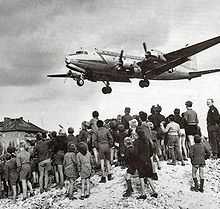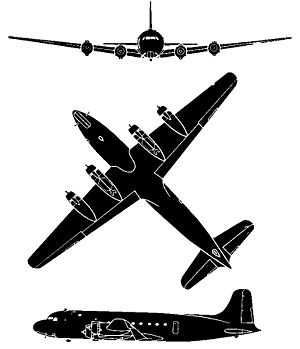Douglas C-54 Skymaster
The Douglas C-54 Skymaster was a four-engined transport aircraft used by the United States Army Air Forces in World War II and the Korean War. Like the Douglas C-47 Skytrain, the C-54 Skymaster was derived from a civilian airliner (the Douglas DC-4).
Besides transport of cargo, the C-54 also carried presidents, prime ministers and military staff. Dozens of variants of the C-54 were employed in a wide variety of non-combat roles such as air-sea rescue, scientific and military research and missile tracking and recovery. During the Berlin Airlift it hauled coal and food supplies to West Berlin.
After the Korean War it continued to be used for military and civilian uses by more than 30 countries. This was one of the first aircraft to carry the President of the United States and to assume the call sign Air Force One.
Operational history
C-54s began service with the US Army Air Forces in 1942, carrying up to 26 passengers. (Later versions carried up to 50 passengers.) The United States Navy also acquired the type, under the designation R5D. The C-54 was one of the most commonly used long-range transports by the U.S. armed forces in World War II. Of the C-54s produced, 515 were manufactured in Santa Monica, California and 655 were manufactured at Orchard Place/Douglas Field, in unincorporated Cook County, Illinois, near Chicago (later the site of O'Hare International Airport).[1]
After World War II, the C-54 continued to serve as the primary airlifter of the new United States Air Force and with the United States Navy.

In late 1945, several hundred C-54s were surplus to U.S. military requirements and these were converted for civil airline operation, many by Douglas Aircraft at its aircraft plants. The aircraft were sold to airlines around the world. By January 1946, Pan American Airways was operating their Skymasters on transatlantic scheduled services to Europe and beyond. Trans-Pacific schedules from San Francisco to Auckland began on 6 June 1946.[2]
President Harry S. Truman signed the National Security Act of 1947, which created the U.S. Air Force, on board "Sacred Cow", the Presidential C-54 which is preserved at the National Museum of the United States Air Force. More than 300 C-54s and R5Ds formed the backbone of the US contribution to the Berlin Airlift in 1948. They also served as the main airlift during the Korean War. After the Korean War, the C-54 was replaced by the Douglas C-124 Globemaster II, but continued to be used by the U.S. Air Force until 1972.
During World War II, the C-54 was used by Franklin D. Roosevelt, Douglas MacArthur and Winston Churchill. The American delegates to the Casablanca Conference used the Skymaster.[3] The C-54 was also used by the Royal Air Force, the Armée de l'Air and the armed forces of at least 12 other nations.
The last active C-54 Skymaster in U.S. Navy service (C-54Q, BuNo 56501, of the Navy Test Pilot School, NAS Patuxent River) was retired on 2 April 1974.[4]
After disposal by the U.S. Air Force and U.S. Navy, many C-54s were modified for use in the civilian fire-fighting and air tanker roles. This included fitting tanks inside and under the fuselage and the fitment of dumping and spraying equipment including on the trailing wing edges. C-54s continued in this role until the late 1990s.
Variants
-

Berliners watching a C-54 land at Tempelhof Airport (1948).
-

A Douglas C-54E Skymaster(c/n 27370, USAAF # 44-9144, NavyBuNo 90414), called Spirit of Freedom, currently operated as a flying museum regarding the Berlin Airlift. www.spiritoffreedom.org
-

VC-54C, the first aircraft used in the role of Air Force One (by President Franklin D. Roosevelt).
-

C-54D repainted in USAAF wartime markings. Chico, California, October 1992
-
_(00910460_131).jpg)
C-54E.
Operators


Accidents and incidents
Disappearance (1950)
On 26 January 1950, a C-54D operated by the United States Air Force disappeared during a flight between Anchorage-Elmendorf Air Force Base (Alaska) and Great Falls-Malmstrom Air Force Base (Montana) with a crew of 8 and 36 passengers (34 service personnel and two civilians).[5][6] No trace of the aircraft or its occupants have ever been found.
Berlin corridor attack (1952)
On 29 April 1952, an Air France Douglas C-54A (registration F-BELI) operating a scheduled service from Frankfurt Rhein-Main Airport to Berlin Tempelhof Airport came under sustained attack from two Soviet MiG 15 fighters while passing through one of the Allied air corridors over East Germany. Although the attack had severely damaged the aircraft, necessitating the shutdown of engines number three and four, the pilot in command of the aircraft managed to carry out a safe emergency landing at Tempelhof Airport. A subsequent inspection of the aircraft's damage revealed that it had been hit by 89 shots fired from the Soviet MiGs. There were no fatalities among the 17 occupants (six crew, 11 passengers) despite the severity of the attack. The Soviet military authorities defended this attack on an unarmed civilian aircraft by claiming the Air France plane was outside the air corridor at the time of attack.[7]
Shoot down (1954)
On 23 July 1954, a Douglas C-54 Skymaster civilian airliner, registration VR-HEU, operated by Cathay Pacific Airways, en route from Bangkok to Hong Kong, was shot down by Chinese Communist La-9 fighters off the coast of Hainan Island, killing 10.[8][9][10][11]
Disappearance (1964)
On 28 March 1964, a C-54A disappeared over the Pacific (about 1120 km west of San Francisco—last reported position: 29°20′N 135°00′W / 29.33°N 135.00°W) on an executive passenger flight from Honolulu International Airport, Hawaii to Los Angeles International Airport, California. The pilot reported a fire in No. 2 engine, which might make it necessary to ditch. Nothing more was heard from the aircraft, nor was any trace of it found despite an extensive search. Three crew and six passengers died in the accident.[12]
Specifications (C-54G)

General characteristics
- Crew: 4
- Capacity: 50 troops
- Length: 93 ft 10 in (28.6 m)
- Wingspan: 117 ft 6 in (35.8 m)
- Height: 27 ft 6 in (8.38 m)
- Wing area: 1,460 ft² (136 m²)
- Empty weight: 38,930 lb (17,660 kg)
- Loaded weight: 62,000 lb (28,000 kg)
- Max. takeoff weight: 73,000 lb (33,000 kg)
- Powerplant: 4 × Pratt & Whitney R-2000-9 radial engines, 1,450 hp (1,080 kW) each
Performance
- Maximum speed: 275 mph (239 kn, 442 km/h)
- Cruise speed: 190 mph (165 kn, 310 km/h)
- Range: 4,000 mi (6,400 km)
- Service ceiling: 22,300 ft (6,800 m)
- Wing loading: 42.5 lb/ft² (207 kg/m²)
- Power/mass: 0.094 hp/lb (160 W/kg)
Notable appearances in media
A C-54, registration C-FIQM (Buffalo 5-721 (tail 57)), was used as a substitute Lancaster bomber due to its similar top speed and maximum payload, for a recreation of Operation Chastise with its bouncing bomb. It was filmed in the UK documentary Dambusters: Building the Bouncing Bomb, Canadian documentary Dambusters Fly Again, Nova season 39 episode "Bombing Hitler's Dams", and Ice Pilots NWT season 3 episode 2 "Dambusters".[13][14][15][16][17][18]
The movie The Big Lift, starring Montgomery Clift shows extensive operations of the C-54 as it was shot on location during the peak of the Berlin Airlift in 1949.
See also
- Related development
- Aircraft of comparable role, configuration and era
- Related lists
- List of aircraft of World War II
- List of military aircraft of the United States
- List of military aircraft of the United States (naval)
- List of airliners
- List of aircraft
References
- Notes
- ↑ FAA: History of O'Hare Int'l Airport
- ↑ Berry, 1967, p.7
- ↑ Lavery, Brian. Churchill Goes to War: Winston's Wartime Journeys. Annapolis: Naval Institute Press, 2007. ISBN 978-1-591141-037.
- ↑ "The Seventies 1970–1980". history.navy. Retrieved: 15 May 2012.
- ↑ Ranter, Harro and Fabian I. Lujan. 'Douglas C-54D-1-DC 42-72469 Snag, YT". Aviation Safety Net, 2008. Retrieved: 15 May 2012.
- ↑ Kennebec, Matt. "Douglas DC-4 C-54D". 1000 Photos, 2010. Retrieved: 15 May 2012.
- ↑ ASN "Aircraft accident description Douglas C-54A-DO F-BELI – near Berlin, Germany". Aviation Safety Net. Retrieved: 15 May 2012.
- ↑ "ASN Aircraft accident Douglas C-54A-10-DC VR-HEU Hainan Island". Aviation Safety Network. Retrieved: 15 May 2012.
- ↑ "Accident details - VR-HEU". Plane Crash Info. Retrieved: 15 May 2012.
- ↑ "VR-HEU Account by passenger: Valerie Parish". Major Commercial Airline Disasters. Retrieved: 15 May 2012.
- ↑ "VR-HEU". The Life & Times of James Harper. Retrieved: 15 May 2012.
- ↑ Ranter, Harro and Fabian I. Lujan. "ASN Aircraft accident Douglas C-54A-10-DC N4726V San Francisco, CA". Aviation Safety Network, 2011. Retrieved: 15 May 2012.
- ↑ "Dambusters Fly Again". History Television, August 2011. Retrieved: 15 May 2012.
- ↑ Chivers, Tom. "The day the Dam Busters returned... in Canada". The Telegraph (London), 2 May 2011. Retrieved: 15 May 2012.
- ↑ Bryan, Hal. "'Ice Pilots' Help Re-Create 'Dambusters'". EAA, 5 May 2011. Retrieved: 15 May 2012.
- ↑ "Dambusters: Building the Bouncing Bomb". Channel 4, 2011. Retrieved: 15 May 2012.
- ↑ "Bombing Hitler's Dams". PBS, WGBH, Nova. Retrieved: 12 January 2012.
- ↑ "Ice Pilots NWT: Season 3, Episode 2: Dambusters". History Television. Retrieved: 15 May 2012.
- Bibliography
- Berry, Peter et al. The Douglas DC-4. Tonbridge, Kent, UK: Air-Britain (Historians) Ltd., 1967.
- Blewett, R. Survivors. Coulsden, UK: Aviation Classics, 2007. ISBN 978-0-9530413-4-3.
- Eastwood, Tony and John Roach. Piston Engine Airliner Production List. West Drayton, UK: Aviation Hobby Shop, 1991. ISBN 0-907178-37-5.
- Francillon, René. McDonnell Douglas Aircraft Since 1920: Volume I. London: Putnam, 1979. ISBN 0-87021-428-4.
- Milberry, Larry. The Canadair North Star. Toronto: CANAV Books, 1982. ISBN 0-07-549965-7.
- Pearcy, Arthur. Douglas Propliners: DC-1–DC-7. Shrewsbury, UK: Airlife Publishing, 1995. ISBN 1-85310-261-X.
- Pickler, Ron and Larry Milberry. Canadair: The First 50 Years. Toronto: CANAV Books, 1995. ISBN 0-921022-07-7.
- Yenne, Bill. McDonnell Douglas: A Tale of Two Giants.Greenwich, Connecticut: Bison Books, 1985. ISBN 0-517-44287-6.
External links
| Wikimedia Commons has media related to Canadair North Star. |
| Wikimedia Commons has media related to C-54 Skymaster. |
| Wikimedia Commons has media related to Douglas DC-4. |
- (1952) AN 01-40NU-1 Handbook Flight Operating Instructions USAF Series C-54G and Navy Model R5D-5 Aircraft
- Canadair DC4M North Star
- Moose Jaw crash at virtualmuseum.ca
- PSA History/Oldtimers Page
- Berlin Airlift Historical Foundation—Operates C-54 "Spirit of Freedom" as flying Berlin Airlift Museum
- Air Force Association page on C-54
- Warbird Alley: C-54 page
- Cockpit View of C-54 During Landing/Taxi
- Boeing McDonnell Douglas page on DC-4
- The last passenger certified & built DC-4s in the world
- Vintage Wings of Canada Canadair North Star showing RR Merlin installation
| ||||||||||||||||||||||||||||||||
| |||||||||||||||||||||||||||||||||||||||||||||||||||||
| |||||||||||
| |||||
| |||||||||||||||||
| ||||||||||||||